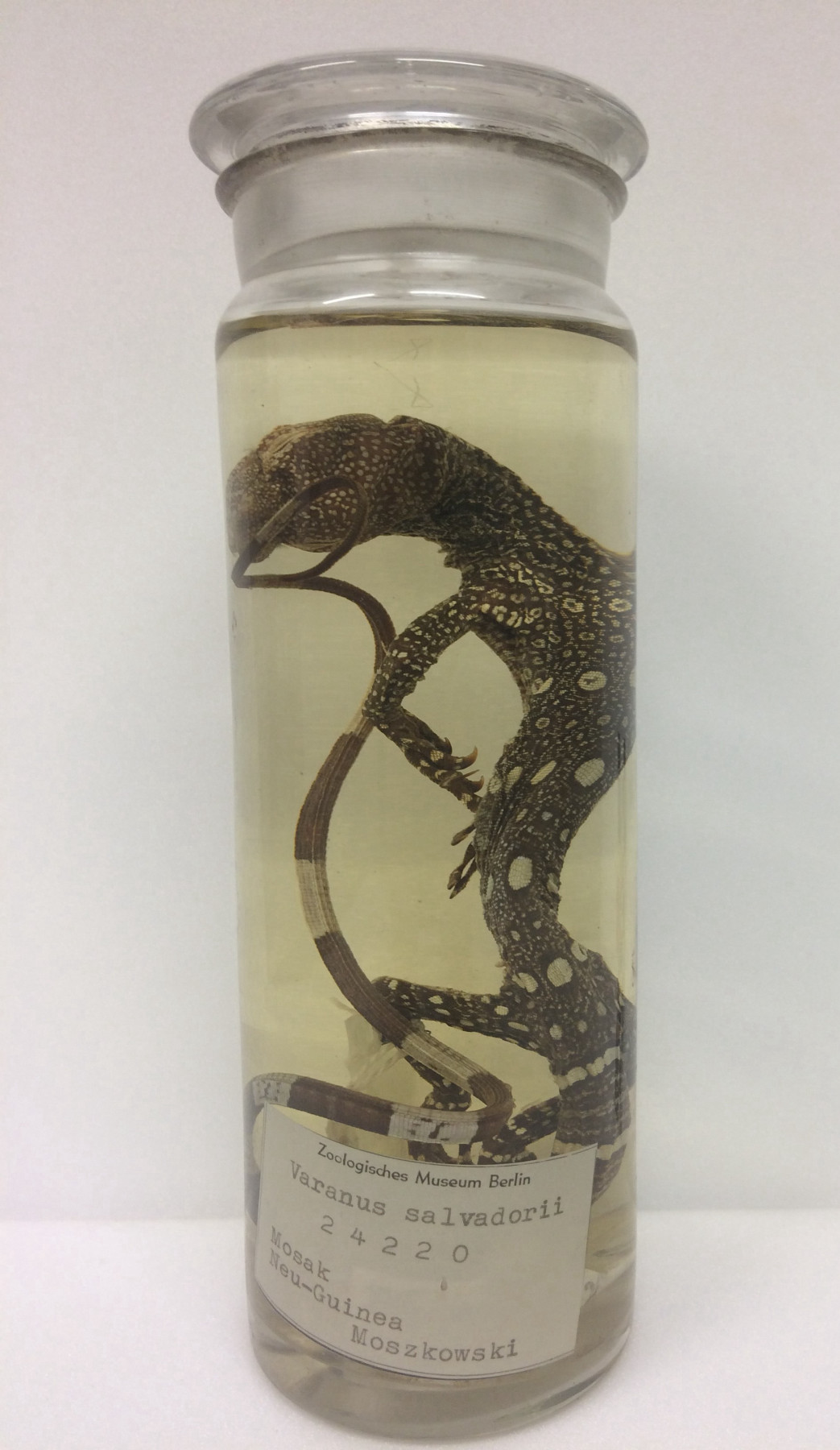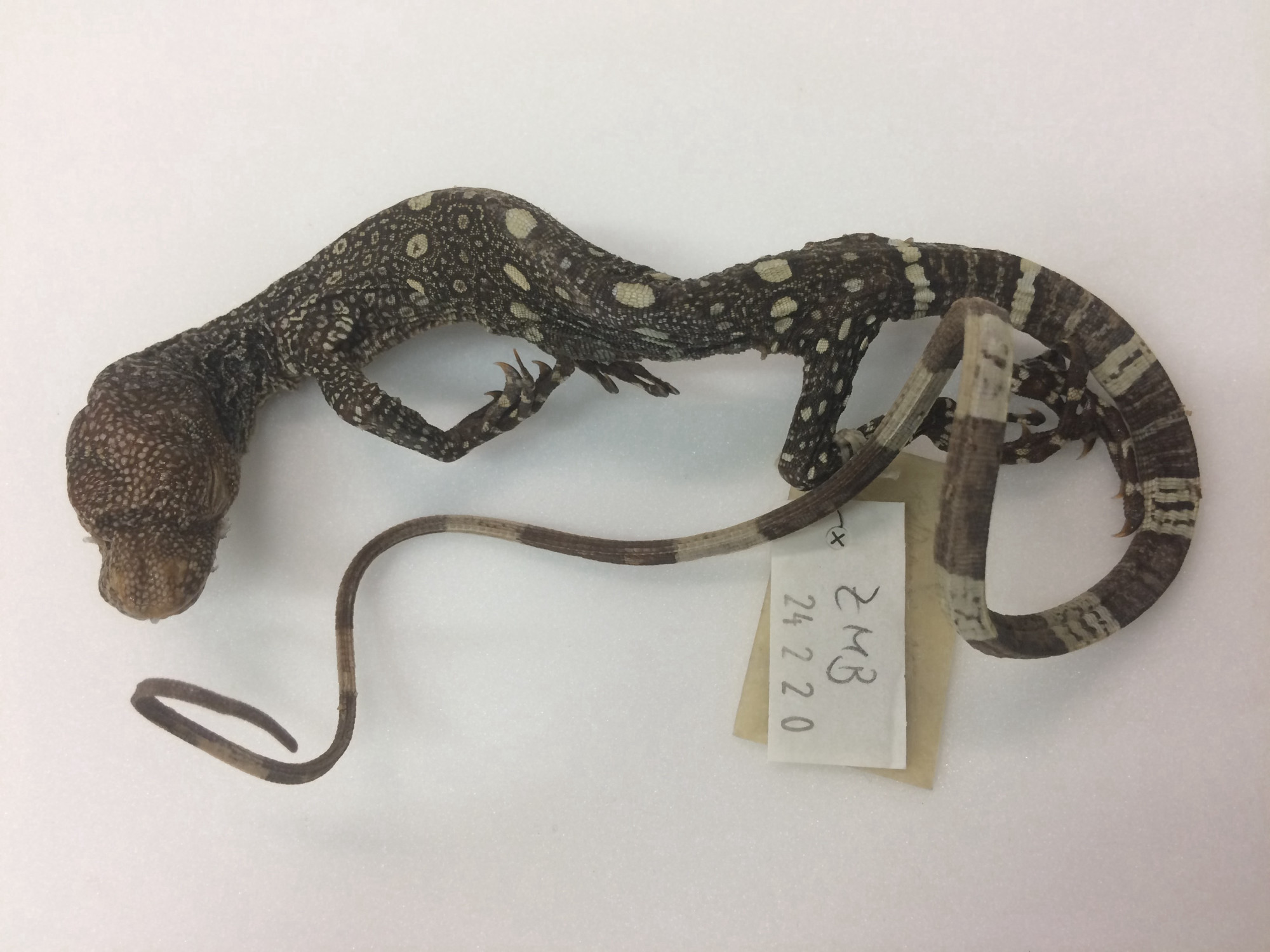
Monitor lizard preserved in alcohol from the Herpetological Collection at the Museum für Naturkunde Berlin. (Image: Frank Tillack/MfN. All rights reserved.)
ZMB 24220. This specimen of a New Guinean monitor lizard at the Museum für Naturkunde Berlin was first entered in the Herpetological Collection’s  inventory catalogue on 7 March 1914 as a specimen of Varanus indicus, the Western Pacific monitor lizard.1 After the
inventory catalogue on 7 March 1914 as a specimen of Varanus indicus, the Western Pacific monitor lizard.1 After the  Second World War, it was noted that the wet specimen had been lost: “Destroyed by the effects of war, 1.12.1950”. Astonishingly, the object then appeared in a catalogue a decade later: in 1961 someone records that the object had been lent to Dr Robert Mertens, curator at the Senckenberg Museum in Frankfurt am Main, for six years.2 After that, it once again disappeared for decades before being rediscovered in March 1990 by the collection assistant Immo Tetzlaff. That same month, the animal was reclassified as a Varanus salvadorii, a Papuan monitor, by a curator from the Bonn Natural History Museum who was visiting the collection.3
Second World War, it was noted that the wet specimen had been lost: “Destroyed by the effects of war, 1.12.1950”. Astonishingly, the object then appeared in a catalogue a decade later: in 1961 someone records that the object had been lent to Dr Robert Mertens, curator at the Senckenberg Museum in Frankfurt am Main, for six years.2 After that, it once again disappeared for decades before being rediscovered in March 1990 by the collection assistant Immo Tetzlaff. That same month, the animal was reclassified as a Varanus salvadorii, a Papuan monitor, by a curator from the Bonn Natural History Museum who was visiting the collection.3
Over the course of the 20th century, the specimen constantly switched between presence and absence – it had supposedly been destroyed, but was never lost, and is now available again. It was moved when the new wet collection was built in the east wing of the museum and had been lent out for several years.

The historic specimen of a monitor lizard sent to the museum in 1914. (Image: Frank Tillack/MfN. All rights reserved.)
This clearly demonstrates the extent to which museum collecting is not just about preserving objects and storing information – one central part of the everyday work is  looking for objects,
looking for objects,  recording and documenting their absence, and constantly comparing the collection with the catalogue.4 This is because the information in the
recording and documenting their absence, and constantly comparing the collection with the catalogue.4 This is because the information in the  catalogue and the collection do not necessarily match up – especially when it comes to historical objects with long
catalogue and the collection do not necessarily match up – especially when it comes to historical objects with long  collection histories. Even though something might be recorded in the catalogue, it does not necessarily mean that the specimen is actually in the collection while, vice versa, not all individual specimens in the collection have necessarily been recorded. This raises the following questions: Where does a collection item have to be in order to be counted as part of the collection? What status do lost objects have? The history of the monitor lizard illustrates that a collection is never at a standstill, that its system of order never works blindly, and that information in the catalogue and the collection has to be compared again and again. When an animal is
collection histories. Even though something might be recorded in the catalogue, it does not necessarily mean that the specimen is actually in the collection while, vice versa, not all individual specimens in the collection have necessarily been recorded. This raises the following questions: Where does a collection item have to be in order to be counted as part of the collection? What status do lost objects have? The history of the monitor lizard illustrates that a collection is never at a standstill, that its system of order never works blindly, and that information in the catalogue and the collection has to be compared again and again. When an animal is  reclassified, it might be re-located within the collection. On the other hand, collections are restructured, moved or new staff members take over, which also has an impact on the holdings, for example on the accessibility and record-keeping of objects. Examining objects again and again can also lead to rethinkings of outdated assumptions and the generation of new knowledge that, in turn, necessitates reclassifications of objects and transforms ontologies.
reclassified, it might be re-located within the collection. On the other hand, collections are restructured, moved or new staff members take over, which also has an impact on the holdings, for example on the accessibility and record-keeping of objects. Examining objects again and again can also lead to rethinkings of outdated assumptions and the generation of new knowledge that, in turn, necessitates reclassifications of objects and transforms ontologies.
- The entry in the catalogue is: “Varanus indicus, [by] Mosak, N.[ew] Guinea, leg. [Max] Moszkowski [staff surgeon]”. I would like to thank collection manager Frank Tillack from the Museum für Naturkunde Berlin for his support and the extensive information he provided.↩
- The recording period given in the catalogue is 13.09.1961 to 22.03.1967.↩
- This is the Alexander Koenig Zoological Research Museum (ZFMK).↩
- This can include, for example, information about the object’s provenance such as where it was found, who supplied it (a collector, donor, or dealer), its scientific description and the history of that description, as well as new classifications and the particulars of any loans.↩